IBM Lab, Yorktown Heights, NY, USA - December 21, 2018 - Grip strength is a useful metric in a surprisingly broad set of health issues. It has been associated with the effectiveness of medication in individuals with Parkinson's disease, the degree of cognitive function in schizophrenics, the state of an individual's cardiovascular health, and all-cause mortality in geriatrics.
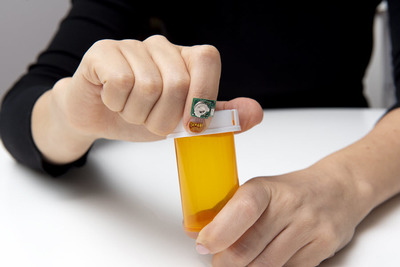 |
Fingernail sensor that can monitor your activities/health.
IBM Lab, Yorktown Heights, NY.
Photo courtesy of IBM / Feature Photo Service |
| |
IBM Lab, Yorktown Heights, NY, USA - December 21, 2018
By: Stephen Heisig and Katsuyuki Sakuma,
IBM Research
Grip strength is a useful metric in a surprisingly broad set of health issues.
It has been associated with the effectiveness of medication in individuals with Parkinson's disease, the degree of cognitive function in schizophrenics, the state of an individual’s cardiovascular health, and all-cause mortality in geriatrics.
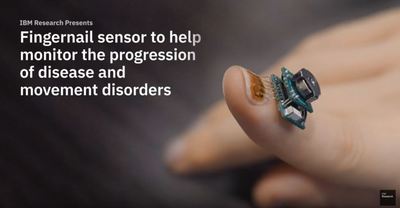 |
IBM Research has created tiny fingernail sensors designed to help clinicians detect and monitor disease progression via AI analysis of grip strength.
Photo courtesy of IBM |
| |
At IBM Research, one of our ongoing challenges is to obtain a better understanding of the effects of diseases on an individual’s overall health, as well as how AI can help clinicians to monitor individuals in their natural environments, and potentially point to indicators and clues into the progression of a patient’s conditions.
 |
IBM Research has created tiny fingernail sensors designed to help clinicians detect and monitor disease progression via AI analysis of grip strength.
Photo courtesy of IBM |
| |
In new research published in Scientific Reports on December 21st, our team details a first-of-a-kind "fingernail sensor" prototype to help monitor human health.
The wearable, wireless device continuously measures how a person's fingernail bends and moves, which is a key indicator of grip strength.
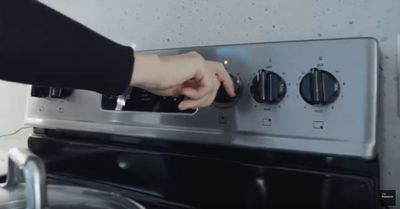 |
IBM Research has created tiny fingernail sensors designed to help clinicians detect and monitor disease progression via AI analysis of grip strength.
Photo courtesy of IBM |
| |
The project began as an attempt to capture the medication state of people with Parkinson's disease.
Getting a new therapy approved requires quantifying how people on the therapy are doing in relation to controls.
The majority of people with Parkinson’s are older, an age group with increasingly brittle, friable skin.
https://www.ncbi.nlm.nih.gov/pubmed/20051606
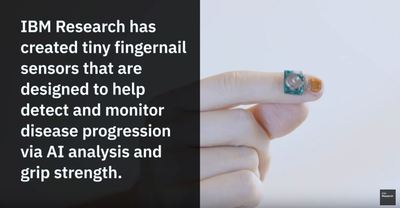 |
IBM Research has created tiny fingernail sensors designed to help clinicians detect and monitor disease progression via AI analysis of grip strength.
Photo courtesy of IBM |
| |
Comprised of skin, nails and hair, the integumentary system covers most of our bodies.
Its primary purpose is to protect our internal components from pathogens, toxins, ultraviolet radiation, dehydration, and changes in temperature. It also provides a structure for sensory receptors of the somatosensory system of neurons across our bodies.
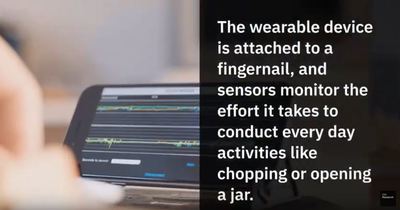 |
IBM Research has created tiny fingernail sensors designed to help clinicians detect and monitor disease progression via AI analysis of grip strength.
Photo courtesy of IBM |
| |
One method to measure a disease’s progression is to attach skin-based sensors to capture things like motion, the health of muscles and nerve cells, or changes in sweat gland activity, which can reflect the intensity of a person’s emotional state.
But with older patients, such skin-based sensors can often cause problems, including infection.
This is where the potential of a fingernail sensor comes into play.
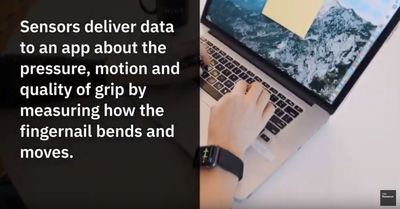 |
IBM Research has created tiny fingernail sensors designed to help clinicians detect and monitor disease progression via AI analysis of grip strength.
Photo courtesy of IBM |
| |
We interact with objects throughout the day using our hands, such as the tactile sensing of pressure, temperature, surface textures and more.
Our team realized it might be possible to derive interesting signals from how the fingernail bends throughout the course of a day, as we use our fingers to interact with our environment, and tap into the power of AI and machine learning to analyze and derive valuable insights from that data.
To view a video demonstrating the motions and movements tracked by the fingernail sensor, click here.
https://www.youtube.com/watch?v=fYyPx8jw_3k
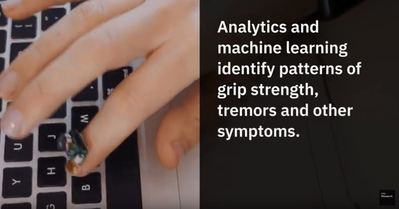 |
IBM Research has created tiny fingernail sensors designed to help clinicians detect and monitor disease progression via AI analysis of grip strength.
Photo courtesy of IBM |
| |
One of the functions of human fingernails is to focus the finger-tip pulp on the object being manipulated.
It turns out that our fingernails deform – bend and move -- in stereotypic ways when we use them for gripping, grasping, and even flexing and extending our fingers.
This deformation is usually on the order of single digit microns and not visible to the naked eye.
However, it can easily detected with strain gauge sensors.
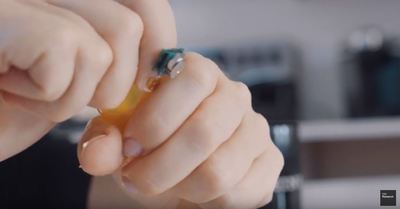 |
IBM Research has created tiny fingernail sensors designed to help clinicians detect and monitor disease progression via AI analysis of grip strength.
Photo courtesy of IBM |
| |
For context, a typical human hair is between 50 and 100 microns across and a red blood cell is usually less than 10 microns across.
Since nails are so tough, we decided to glue a sensor system to a fingernail without worrying about any of the issues associated with attaching to skin.
Our dynamometer experiments demonstrated we could extract a consistent enough signal from the nail to give good grip force prediction in a variety of grip types.
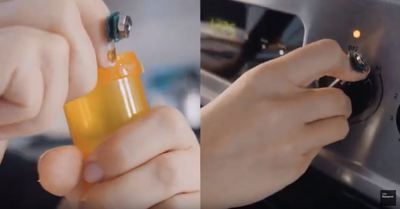 |
IBM Research has created tiny fingernail sensors designed to help clinicians detect and monitor disease progression via AI analysis of grip strength.
Photo courtesy of IBM |
| |
We also found it is possible to deconvolve subtle finger movements from nail deformation.
We were able to differentiate typical daily activities which all involve pronation and supination such as turning a key, opening a doorknob or using a screwdriver.
An even more subtle activity is finger writing, and we trained a neural network to produce a very good accuracy (.94) at detecting digits written by a finger wearing the sensor.
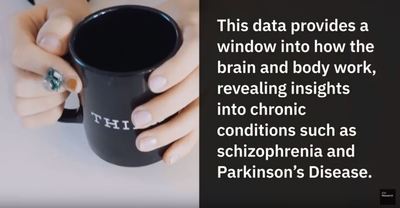 |
IBM Research has created tiny fingernail sensors designed to help clinicians detect and monitor disease progression via AI analysis of grip strength.
Photo courtesy of IBM |
| |
Our system consists of strain gauges attached to the fingernail and a small computer that samples strain values, collects accelerometer data and communicates with a smart watch.
The watch also runs machine learning models to rate bradykinesia, tremor, and dyskinesia which are all symptoms of Parkinson's disease.
By pushing computation to the end of our fingers we've found a new use for our nails by detecting and characterizing their subtle movements.
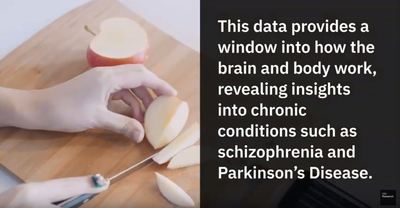 |
IBM Research has created tiny fingernail sensors designed to help clinicians detect and monitor disease progression via AI analysis of grip strength.
Photo courtesy of IBM |
| |
With the sensor, we can derive health state insights and enable a new type of user interface.
This work has also served as the inspiration for a new device modeled on the structure of the fingertip that could one day help quadriplegics communicate.
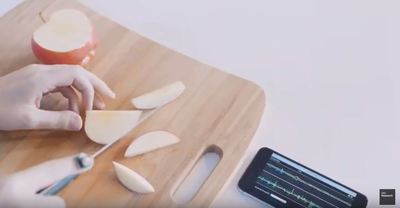 |
IBM Research has created tiny fingernail sensors designed to help clinicians detect and monitor disease progression via AI analysis of grip strength.
Photo courtesy of IBM |
| |
Video
IBM’s tiny fingernail sensor monitors diseases & movement disorders
https://www.youtube.com/watch?v=fYyPx8jw_3k
Source: IBM Research
https://newsroom.ibm.com/
ASTROMAN Magazine - 2018.12.21
IBM Expands Strategic Partnership with Samsung to Include 7nm Chip Manufacturing
https://www.astroman.com.pl/index.php?mod=magazine&a=read&id=2643
ASTROMAN Magazine - 2018.12.17
IBM: Introducing SpectrumAI with NVIDIA DGX for deep learning
https://www.astroman.com.pl/index.php?mod=magazine&a=read&id=2642
ASTROMAN Magazine - 2018.11.02
IBM Blockchain: How Dubai is Becoming the Blockchain Capital of the World
https://www.astroman.com.pl/index.php?mod=magazine&a=read&id=2615
ASTROMAN Magazine - 2018.11.01
IBM To Acquire Red Hat, Completely Changing The Cloud Landscape And Becoming World's #1 Hybrid Cloud Provider For USD 34 Billion
https://www.astroman.com.pl/index.php?mod=magazine&a=read&id=2614
ASTROMAN Magazine - 2018.10.12
IBM and NVIDIA Collaborate to Expand Open Source Machine Learning Tools for Data Scientists
https://www.astroman.com.pl/index.php?mod=magazine&a=read&id=2605
ASTROMAN Magazine - 2018.09.06
IBM think Warsaw 2018 - Technologia w służbie ludzkości - 18 września 2018, Warszawa, Hotel Hilton
https://www.astroman.com.pl/index.php?mod=magazine&a=read&id=2579
ASTROMAN Magazine - 2018.06.12
IBM Systems. Reaching the Summit: The World's Smartest Supercomputer
https://www.astroman.com.pl/index.php?mod=magazine&a=read&id=2530
ASTROMAN Magazine - 2018.03.23
How IBM Watson Assistant Helps You Treat Customers Like VIPs
https://www.astroman.com.pl/index.php?mod=magazine&a=read&id=2468
ASTROMAN Magazine - 2018.03.22
IBM Demonstrates New Breakthrough in AI Performance
https://www.astroman.com.pl/index.php?mod=magazine&a=read&id=2467
ASTROMAN Magazine - 2018.03.21
IBM Services: A New Era of the Smart Enterprise
https://www.astroman.com.pl/index.php?mod=magazine&a=read&id=2466
ASTROMAN Magazine - 2018.03.21
Think 2018 Chairman's Address: Putting Smart to Work
https://www.astroman.com.pl/index.php?mod=magazine&a=read&id=2465
ASTROMAN Magazine - 2018.01.20
IBM and Salesforce Strengthen Strategic Partnership
https://www.astroman.com.pl/index.php?mod=magazine&a=read&id=2428
ASTROMAN Magazine – 2018.01.19
Maersk and IBM to Form Joint Venture Applying Blockchain to Improve Global Trade and Digitize Supply Chains
https://www.astroman.com.pl/index.php?mod=magazine&a=read&id=2427
ASTROMAN Magazine - 2017.12.06
IBM Unveils Industry's Most Advanced Server Designed for Artificial Intelligence
https://www.astroman.com.pl/index.php?mod=magazine&a=read&id=2393
Editor-in-Chief of ASTROMAN magazine: Roman Wojtala, Ph.D.
|

